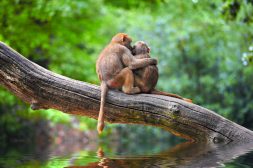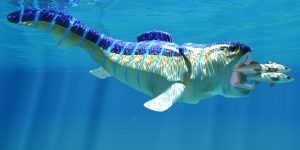Definition
noun, plural: phycobilins
A water-soluble accessory pigment found in red algae and cyanobacteria
Supplement
Photosynthetic autotrophs have pigments that absorb light energy to synthesize complex organic material from inorganic sources. There are three basic types of photosynthetic pigments: (1) chlorophylls, (2) carotenoids, and (3) phycobilins. Chlorophyll is the major light-absorbing pigment within the chloroplast of photoautotrophs, such as higher plants. There are photoautotrophs that have additional pigments to aid in light absorption. Their pigments act as an accessory, thus the name accessory pigments, in a way that they do not transfer light energy directly to the photosynthetic pathway but to the primary pigment, chlorophyll. Examples of accessory pigments are carotenoids and phycobilins. One of the distinctive features of phycobilins is their water solubility. In contrast to carotenoids that are insoluble to water, phycobilins are water-soluble proteins.
Phycobilins are found in red algae and cryptomonads. They are also found in cyanobacteria. Inside the cells of these organisms, the phycobilins collect light energy from the sun and pass this energy to the primary pigment, which is the chlorophyll. In eukaryotes such as red algae, they are found in the stroma of the chloroplast. In prokaryotes such as cyanobacteria, they are found in the cytoplasm. The light energy they absorb is essential for the production of organic molecules by the process of photosynthesis.
Phycobilins that are covalently linked to proteins are referred to as phycobiliproteins, which serve as chromophores. Examples of phycobiliproteins are phycoerythrin, phycocyanin, allophycocyanin, etc.
See also:
Dictionary > Phycobilin
You will also like...

Soils
Nutrients in the soil are essential to the proper growth of a land plant. This tutorial deals with the properties of soi..

Leaves
Leaves are the major photosynthetic organ of a plant. Apart from that, they are also crucial to water movement. In this ..

Principles of Hormonal Control Systems
Hormones are essential in the regulation of the activity of the various biological systems of the human body. The ineffi..

Population Regulation in an Ecosystem
With regard to the population size of a species and what factors may affect them, two factors have been defined. They ar..

Fruits, Flowers, and Seeds
This tutorial deals with the structure and function of flowers, fruits, and seeds. Also included here are the types of f..

Fish
The sea was teeming with life. Eventually, through reproduction and continued variation, fish came about. There are over..

